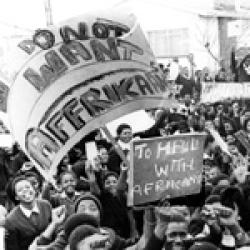
Published date
13 June 1976
The Naledi High School branch of the South African Students Movement (SASM) held a meeting, which was attended by representatives of all Soweto high schools, at which it was decided that protests would be held on 16 June against the use of Afrikaans as a medium of education in Black schools.
The students decided to establish the Soweto Students' Representative Council (SSRC), an action committee made up of two representatives from each school to plan and coordinate the protest march. During the early hours, on 16 June 1976, Tsietsi Mashinini led the peaceful protest of approximately 20 000 learners in Soweto. With one goal and one voice, they marched through the streets of Soweto, but sadly the march culminated in the death of Hector Peterson.
The Apartheid Government had, in 1953, enacted The Bantu Education Act, which established a Black Education Department in the Department of Native Affairs. The key function of this department was to compile a curriculum that suited the "nature and requirements of the black people." The architect of the legislation, Dr Hendrik Verwoerd, the then Minister of Native Affairs, said; “Natives [Africans] must be taught from an early age that equality with Europeans [Whites] is not for them."
References
About African History,‘16 June 1976 Student Uprising in Soweto,’ [online] Available at www.africanhistory.about.com, [Accessed: 13 May 2011]|
South African History Online,‘The Youth Struggle,’ [online] Available at www.sahistory.org.za, [Accessed: 13 May 2011]